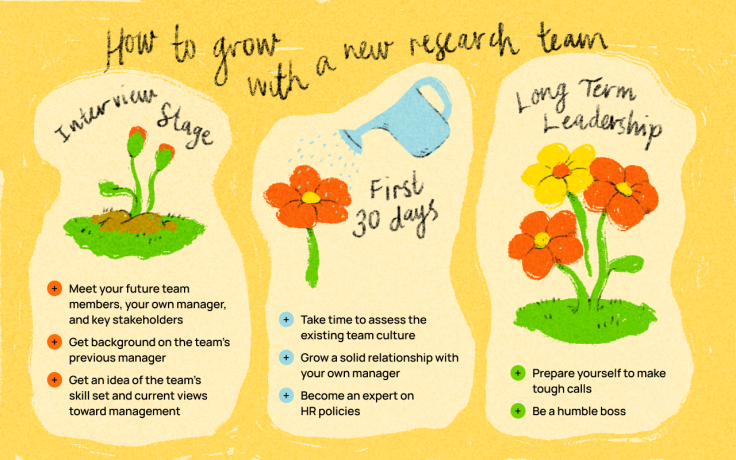The challenges of inheriting a research team

People management is a challenging and rewarding career path. As is the case for the UX research field in general, UX research managers come from different backgrounds, and previous management experience eases a transition into this role. If you’ve been hired as the first lead or manager in a company or are building a team from scratch, you’ll be responsible for creating a vision and hiring strategy and growing the team with care.
But growing a team yourself may not be the situation you encounter. It could be that you are inheriting a team already in place. The team might be relatively new, but it will have its strengths, weaknesses, and an existing dynamic—one that emerged before you were in the picture. It is in your best interest to understand these dynamics as early as possible and approach your leadership role with a firm understanding of the history.
I’ve spent 18 years in management roles, first in a university where I managed large lecture courses and graduate student research projects. Then in UX, I first built my own team of UX researchers and service designers and later inherited an existing team. This last challenge—inheriting an existing team—is the focus of this article.
Before you start the process of interviewing for such a role, come up with a plan. If you have a background in research, you are well equipped to define the “problem space”—the one you are being hired to improve and grow. There are important considerations to keep in mind at three stages: While you are interviewing for the role, during your first 30 days in the role, and the long-term leadership you bring to the role.
Interview stage
Candidates often approach a job interview like its sole purpose is to evaluate their fit for a role. But it’s also about determining whether the role is a good fit for you. This means gathering as much information as possible in the hours you have with these individuals before you decide whether to take on the role. At this moment, assess whether you see this role as an exciting challenge or one that’s raising red flags. The interview process should ensure that you meet your future manager, your reports, and a selection of key stakeholders, so participants on both sides can get a good idea of compatibility.

Find out who is currently managing the team. It could be this person has left the organization or has moved to another role. Or, this person is going to be your manager and is moving up the food chain or will be managing a smaller number of reports. If possible, ask them about their experience managing the team. How do they describe the individuals on the team? How did they assess performance? Have they helped the team actively improve their craft or stakeholder management skills?
You are still a candidate, so this information will necessarily remain somewhat abstract. Do your best to get a good idea of what—manager to manager—leading this team is like and what tools are in place to assess performance.
Meet your future team, and assess their expertise and existing views toward management. Ensure you have time to ask about each team member’s background, strong points, and how they want to grow professionally in the interview. Get an idea of how they have experienced management. Are they used to being included in decision-making? Do they have a clear idea of how they can move forward at this company?

Use your first 30 days wisely
Congratulations, you’ve decided to take the plunge! Establish a routine and spend quality time with your team from day one, both individually and all together.
Assess existing team culture. How often is your team used to meeting? How does your team work on research projects—do they go in solo or pair up? Were they leading the work themselves? Who decided which projects to prioritize? Dive deeper into your team’s strengths and weaknesses, both on a team and individual level, and start to understand how things have worked for them and where they can improve.
Dive deep with the former manager, if possible. Listen to their assessment of each team member’s skill level. Have a look at past evaluations. Do you see challenges that may be looming? For those who might be struggling, how has this been addressed? For those excelling in their role, are they on a clear promotion track? If the former manager is unable or unwilling to share these details, ask why. Now is the time to be direct.

Grow a solid relationship with your own manager. Your manager is in a senior management role managing managers and will need to ensure your time together is divided between catching up on your team’s challenges and focusing on your own career development. Make sure to clarify what your managers’ expectations are. For example, are you responsible for roadmap planning? What are the deadlines for this, and who do you need to include in this process? What are your management responsibilities? How will your team’s performance be evaluated, and what is your role in this?
Become an expert on HR policies. How do your reports request access to software? How do they report illness or request a holiday? Most likely, it will be your responsibility to approve these requests, so make sure you know what’s expected of you. How are you expected to evaluate your team members, and when? What if you run into problems with one of your reports—what are the necessary training or disciplinary procedures? It’s better to know how all of these administrative responsibilities work before you find yourself in a situation that requires quick action.
Long-term leadership
By now, you’re still the new kid on the block, but you’ve settled into your role. You know where the vital Slack channels are, and you’ve met and interviewed your most important stakeholders. Most crucially, you’ve begun to build a relationship with your team members. Perhaps you’re already gearing up to expand the team, where you will act as hiring manager. There’s plenty to consider in the long term, but here are a couple of points to prioritize.
Prepare yourself to make tough calls. It could be that one of your reports isn’t performing the way they should for the level they’re at. Or they’re unhappy with their role for another reason and are not improving despite your intervention.

Letting people go will lead to challenges with your team and broader stakeholders. This is a difficult part of being a manager. If you have built a strong relationship with your own manager, they should support you. And because you took the time to get to know HR procedures, you�’ll know how to proceed if you need to let someone go.
Finally, and most importantly, always try to be a humble boss. Inheriting an existing team can be intimidating. You are the new kid on the block, but you are also the manager. You’ll need to strike the right balance between learning the ropes and taking the helm. Any changes you decide to implement, do so with a clear understanding of the team’s history. Change for the sake of change or as a way to assert authority will probably not be well-received.
Always be honest about how you’re feeling. If you don’t know something, don’t be afraid to ask. Be open to feedback and admitting you’re wrong. If you can demonstrate humble yet decisive leadership, your team will be your greatest asset for success in this role.
Written by Janelle Ward, Principal Consultant, Janelle Ward Insights. Janelle has led UX research at digital product companies, both as a founding lead and as a manager upskilling and growing existing research teams. Janelle has a background in psychology and digital communication and spent a decade as an assistant professor before transitioning to UX research. She writes regularly about career and research topics. Outside of work, her life is a mix of parenting, partnering, reading great fiction (and trying to write it), caring for horses (not hers), and a dog and two cats (hers).


